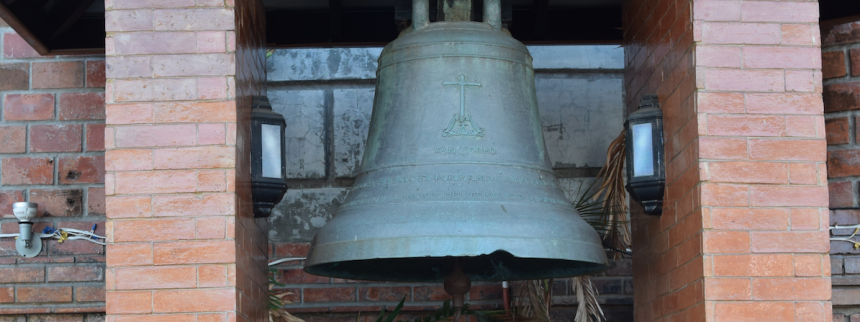
After Mass in the Cathedral of San Fernando La Union, one of the parish priests, Fr. Ronald Chan, walked me to the front of the Church. A monument displaying an old Church bell stood at one side of the main entrance. There is a story about this bell: In the earlier part of the twentieth century, US military forces seized the bell from the Cathedral. It was alleged that guerrilla forces were robbing bells to melt them down for bullets. In any case, the church lost its bell and, with time, any memory of its whereabouts.
In the meantime, the US officer who commandeered this “weapon of war” entrusted it to West Point as a trophy. Some of the readers will know what I mean when I refer to the closing scene in the first Raiders of the Lost Ark. That’s what happened to the bell, where it remained for almost a century.
US veterans ran across the Church bell trying to tidy things up at West Point storage. After some research, it was found that the San Fernando Cathedral in the Philippines was its proper home. Fr. Chan was told that if he formally requested the bell’s return it would be handled with “prompt” military dispatch. So, the bell found its way back home with a plaque acknowledging the “goodwill” gesture to the enduring friendship between the USA and the Philippines.
Tongue-in-cheek kidding aside, the people of the two nations share much history. Time, increased ease of travel, and globalized communication have deepened that relationship in ways that may seem imperceptible to us in the United States.
After Mass in Alaminos, the bishop commented about the enthusiastic reception given to me from the parishioners. He said Americans are still regarded well in the Philippines, especially when we enter into the rhythm of their lives.
Almost everyone, to whom I mentioned California as my home, knew of it. Most have a relative who lived in California. At Mass, the English version of the Roman Missal was readily available and, judging from their condition, well used. Choirs who accompanied our celebrations drew easily from contemporary American Catholic hymnody. Every school age child or altar server introduced to me tried their best English on me, “How are you, sir?” Many of the bishops were more familiar than me with the star players on the Sacramento Kings.
This exchange is not a one-way street. Health care — especially in the Sacramento region — is significantly impacted by an able and amiable Filipino workforce. The English-speaking Catholic ministries are energized by Filipino vitality. Some of the strongest parish youth ministry programs are driven by Filipino peer ministers. Almost a third of the active clergy are Filipino, mostly immigrants but the more recent Filipino ordinations are either born here or raised mostly in the United States.
Both in the Philippines as well as the USA there is an admiration for the Filipino family. Strong family bonds compel emigration for the sake of the family, then help sustain individuals while away, but also are tested by the stresses of a globalized world. I expressed my appreciation to the bishops I met for the contribution made by Filipinos to the vitality of the Catholic Church in California and elsewhere. They were grateful to know that Filipinos were making a positive contribution. Our pastoral realities are very different yet the same family bonds also binds our churches closer together. Sustaining the health of the family as well as the Church will depend on us cultivating those bonds that will make us stronger together.
---
Click here for a Facebook photo album that follows Bishop Soto's journey in the Philippines.
Did you miss a dispatch? Find them all here: First | Second | Third | Fourth | Fifth | Sixth | Seventh

